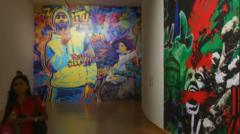An art exhibition held in Thailand recently became the focal point of a significant international dispute, drawing attention to China’s increasing efforts to exert influence beyond its borders. The show, which was staged in Thailand, featured highly sensitive political themes that ultimately led to accusations of censorship and the forced displacement of its organizers. Central to the controversy was the exhibition’s inclusion of works by artists from Tibet, the Uyghur region of China, and Hong Kong. These regions are subjects of ongoing human rights concerns and political disputes involving Beijing. The art pieces reportedly explored themes of identity, freedom, and resistance, reflecting the perspectives of communities whose voices are often suppressed.
Sources close to the exhibition indicated that intense pressure was brought to bear on the organizers and the venue. This pressure, widely attributed to Chinese diplomatic or governmental channels, aimed to halt the exhibition or significantly alter its content. The incident underscores a broader pattern where Beijing allegedly seeks to silence critical voices and control narratives globally, even when events occur in sovereign nations like Thailand. The severe backlash and explicit attempts at censorship had dire consequences for the exhibition’s creators. The Burmese curators responsible for bringing the diverse collection to light were compelled to flee their location due to the escalating threats and diplomatic pressure. They have since sought refuge in the United Kingdom, where they continue to advocate for artistic freedom and human rights. While the curators’ plight highlights the risks involved, the broader narrative also touches upon artists potentially facing similar intimidation. The incident serves as a stark reminder of the challenges faced by artists and cultural figures who choose to address politically sensitive subjects, particularly those that challenge powerful state narratives.



